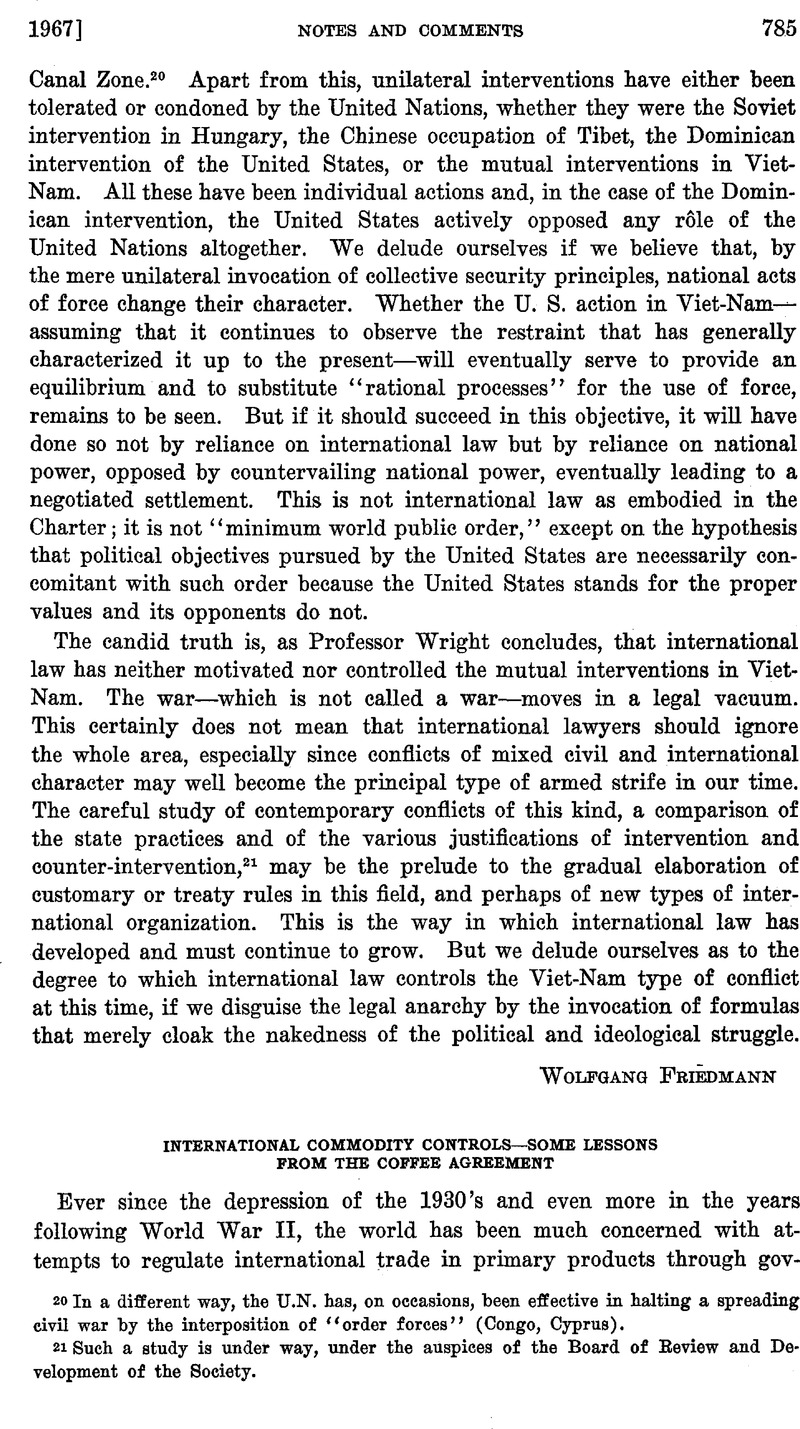Article contents
International Commodity Controls—Some Lessons from the Coffee Agreement
Published online by Cambridge University Press: 28 March 2017
Abstract

- Type
- Notes and Comments
- Information
- Copyright
- Copyright © American Society of International Law 1967
References
1 See, e.g.,Final Act and Report of the U.N. Conference on Trade and Development, Part II, See. II, and Annex A.II.1 (E/Conf. 46/139, E/Conf. 46/141, Vol. 1) (1964). See, e.g.,Report by the Secretary General of the Conference (Prebisch Report), Part I, Ch. 2, Part II, Ch. ID (E/Conf. 46/141, Vol. 2) (1964).
2 The International Wheat Agreement, which establishes a maximum and minimum range of wheat prices, has not come into play recently, due primarily to the policies of the principal exporters, Canada and the U. S.; the International Tin Agreement, which attempts to operate through a buffer stock, has not recently been able to exercise control over the tin trade; the International Sugar Agreement has been inoperative since failure to agree on a Cuban quota, and there for on all quotas, in 1961; and the International Olive Oil Agreement is primarily concerned with promotion and with the prevention of unfair competition, and contains no regulatory mechanism.
3 For the one survey for lawyers in English, see Symposium, ‘ ‘ International Commodity Agreements,” 28 Law and Contemporary Problems 271 (1963). See also Krumme, “International Commodity Agreements: Purposes, Policy and Procedure“ (Student Note), 31 G. W. Law Rev. 784 (1963). For a recent comprehensive study in German, see Knote, International Rohstoffabkommen aus der Nachkriegszeit (1965).
4 For accounts of this development not specifically addressed to lawyers, see, e.g., Baranyai and Mills, , International Commodity Agreements (Mexico City, 1963)Google Scholar; and Rowe, , Primary Commodities in International Trade (Cambridge, 1965)Google Scholar. Knote (op. cit.note 3) adds the fascinating information that as early as 1864, at the height of laissez faire,France, Belgium, The Netherlands, and Great Britain concluded a convention in Paris to regulate export subsidies and drawbacks in sugar. There were five additional conferences looking to a sugar agreement among the European countries, and a Brussels Convention of 1902 creating a permanent Sugar Commission lasted until 1920.
5 The Havana Charter for an International Trade Organization contained an entire chapter (Ch. VI) setting down standards for international commodity agreements, among them, that commodity agreements should be open to all countries on a nondiscriminatory basis; that they should be governed by a Council in which consumers and producers are equally represented; that agreements be concluded for periods of not more than five years; and that there be full publicity for all arrangements made, as well as all objectives of the agreement. While the Havana Charter never entered into force, Ch. VI is indirectly incorporated by reference in the amended version of the GATT, Art. XX (h) and Ad Art. XX. It is interesting that the paper in the Law and Contemporary Problems survey on the international law of commodity agreements (note 3 above) deals exclusively with the relation of commodity agreements to the Havana Charter and the GATT. Walker, , “International Law of Commodity Agreements,” 28 Law and Contemporary Problems 392 (1963)CrossRefGoogle Scholar.
6 There are clearly differences in grades of coffee both in taste and in price, the three principal kinds being Milds (Colombia and Central America), Brazils, and Robustas (most of Africa). Since coffees are generally blended and it is possible, for example, to “manufacture” Brazils by mixing Milds and Robustas, it is not clear to what extent a shift to Robustas reflects changes in tastes as contrasted with response to price cuts.
7 ‘’Report of the Advisory Panel on the Legality of a System for the Selective Adjustment of Quotas,” reprinted in 5 Int. Legal Materials 195 (1966).
8 Resolutions of International Coffee Council, Eighth Session, London, Aug. 22- Sept. 6, 1966, reprinted in 5 Int. Legal Materials 1161 (1966). In practice, the flexibility of the Selective Adjustment Scheme for making cuts in permissible exports in response to price declines has been limited because the drafters of the resolutions, influenced by the Jurists’ Panel, put limitations on the number and extent of cuts that would be permitted. At this writing no price increases that would cause expansion in the permissible exports under the Scheme have occurred.
9 In a somewhat different context, relating to an unforeseen need in international civil aviation, Bin Cheng recently wrote: “ I t is certainly desirable that international organizations should, in principle, avoid de factoamendments of the Constitution and conscious deviation from the Rule of Law for the sake of expediency.” Bin Cheng, “Nationality and Registration of Aircraft—Article 77 of the Chicago Convention,“ 32 J. Air Law and Commerce 551, 560-561 (1966). But the issue to which he was addressing himself—international registration of aircraft—was far less central to the success of the organization there involved (ICAO) than the problem faced by the International Coffee Organization.
10 See, e.g.,Rowe, op. cit.,note 4, esp. at 180-182, 209-220; see also Knote, op. cit. note 3, at 29-30.
11 For a contrary view, compare the following assertion by Prebisch in his report to the UNCTAD: “The effort to conclude commodity agreements can hardly succeed so long as such agreements are regarded as a compromise between exporting and importing countries and if they are based merely on the idea of dealing with market fluctuations.''
12 By Res. 110, Sept. 5, 1966, the International Coffee Council established a “high level working group,” composed of importing and exporting members and the Executive Director, to address the problem of production goals, diversification, control of production, retention, stocks, and the like, hopefully in collaboration with the World Bank, IMP and PAO. In November, 1966, the World Bank served as host to a meeting of a working group devoted to these problems.
- 2
- Cited by


